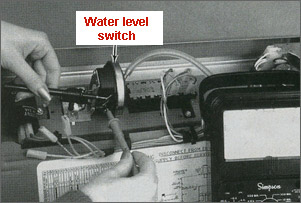 |
 |
|
 |
 |
 |
|
 |
Whirlpool Washer Repair

Appliance repair
>
Washers
>
Whirlpool Washer >
Testing/Replacing water level switch
READ THIS FIRST!
Warning! To avoid personal
injury or death, always unplug the appliance or disconnect the power before
attempting any repairs. Always turn off the gas at the source before repairing
any gas appliance. Always wear safety glasses when using tools. Keep loose
clothing and hair away from any moving parts. Safety is of major importance when
performing any service or repair on any electrical appliance.
By reading this page you state that you have read and agreed to RepairAve.com's
Disclaimer and Terms of Use. |
Testing and Replacing Water Level Switch
Whirlpool® washing machines (direct drive)
|
|
 |
| Instructions |
Illustrations |
Water level switch,
located inside the console, is used in controlling the amount of water
entering the washer. There are different water levels, depending on the
model you have. Selections might include "extra small", "small", "medium",
"large" and "extra large", plus a "reset" option. Some models have a fixed
water level switch. This allows for just one water level in the washer.
We'll need an Ohmmeter to test the water level switch. There are
three color-coded wires going to this switch: violet (V), pink (P), and
tan (T). The violet wire carries the current (electricity) from the timer
to the water level switch. Contacts inside the switch send current back
through either the pink wire, meaning an empty tub, or tan wire, meaning a
full tub of water. |
 |
 Before testing, lets do the following: Before testing, lets do the following:
-
First, disconnect power to the washer (or unplug it)
- Use the
Removing washer cabinet article
to help you get to the switch.
Testing with empty tub (for testing with a full tub of water, see
below)
1. Remove one wire at a time, carefully labeling each wire
according to the terminal marking on the water level switch. This
procedure should assure that the right wire is reconnected to the right
terminal.
2. Set the ohmmeter scale to the lowest ohms setting and ZERO the
meter.
3. Touch and hold one ohmmeter probe to the terminal V.
4. Touch the other ohmmeter probe to the terminal P.
5. The ohmmeter should show ZERO resistance (continuity). If not,
the water level switch is bad and needs to be replaced.
6. Touch and hold one ohmmeter prove to the terminal V.
7. Touch the other ohmmeter probe to the terminal T.
8. The ohmmeter should show an open circuit (no continuity) when
checking these two terminals. If not, the water level switch is bad and
needs to be replaced. |
 |
 To find the right water level switch for your washer, enter the washer model
number below
To find the right water level switch for your washer, enter the washer model
number below
(where is the model number?)
|
Testing with a full tub
of water
1. Remove one wire at a time, carefully labeling each wire
according to the terminal marking on the water level switch. This
procedure should assure that the right wire is reconnected to the right
terminal.
2. Set the ohmmeter scale to the lowest ohms setting and ZERO the
meter.
3. Touch and hold one ohmmeter probe to the terminal V.
4. Touch the other ohmmeter probe to the terminal T.
5. The ohmmeter should show ZERO resistance (continuity). If not,
the water level switch is bad and needs to be replaced.
6. Touch and hold one ohmmeter probe to the terminal V.
7. Touch the other ohmmeter probe to the terminal P.
8. The ohmmeter should show an open circuit (no continuity) when
checking these two terminals. If not, the water level switch is bad and
needs to be replaced.
Note: If you checked the water level switch with a full tub of
water first, the water left in the tub must be emptied by hand. |
 |
 |
- Troubleshooting guide
-
How washers work
- Removing washer cabinet (Taking your washer apart)
- Replacing timer knob
- Testing/Replacing water level switch
- Testing/Replacing water inlet valve
- Replacing water inlet hoses
- Repairing agitator problems
- Replacing drive block
- Checking/Replacing water pump
- Testing/Replacing motor switch
- Checking/Replacing motor drive coupling
- Testing/Replacing washer drive
motor
If your problem is not listed, try
this site.
|
|
|
 |
|
 |





